Dance Now presents its fall festival at Joe’s Pub September 7 through 10.
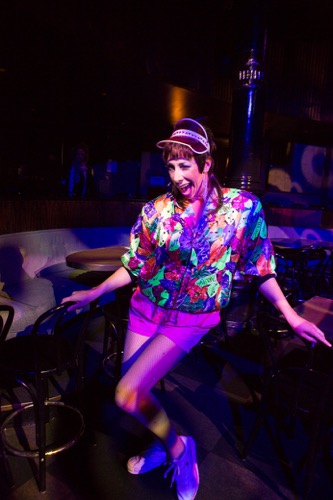
TruDee (aka Deborah Lohse) welcomes the Joe’s Pub crowd. Photo: Yi-Chun Wu
How often do you see ten dances in under an hour-and-a-half? Had Joe’s Pub not initiated its annual Dance Now Festival eight years ago, you’d have had to think back to the 1920s and the well-filled solo programs that Martha Graham and others put on. Robin Staff, the producer and executive director of Dance Now, must lay down the law as to time allotted; in the opening night program, one work was identified as an excerpt, and one was a “condensed version.” No one takes a bow until everything’s over but the paying of the food and drink bill.
Four different programs between September 7 and September 10 offered more than 26 new works by more than 40 choreographers on a stage so tiny that a singer or a comedian would feel more at home on it than a dancer. Yet dance goes on, while waitpersons thread adroitly between tables of spectators, orders are delivered sotto voce, and glasses refrain from clinking. The host, TruDee (Deborah Lohse), identifies herself as a valiantly eager cruise director. With a modified New York accent and an alarming blouse, she makes a couple of appearances to warm up the crowd, even performing a (purposefully) gauche fortune-telling shtick with an obliging audience member.
Over the years, it seems to me that the choreographers who present work in Dance Now’s adventurous series have tailored their ideas to fit not just the space, but the off-beat club atmosphere. Few tears fall, the “fourth wall” between audience and performers may be violated, and much laughter ricochets off the patterned reflective surface that backs the stage and turns whatever gaudy colors the lighting designer, Lauren Parrish, can provide.
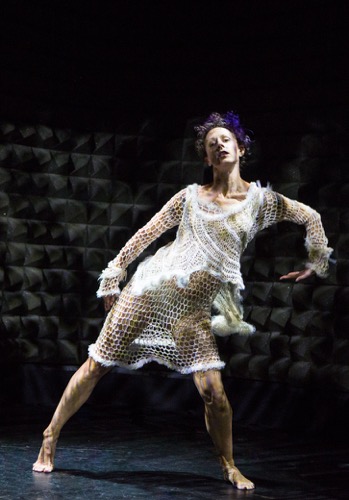
Meredith Fages in Heidi Latsky’s Timestamp #3. Photo: Yi-Chun Wu
Yet the acts in this cabaret vary in tone and intent, even though some have much in common. Heidi Latsky’s Timestamp #3, Khaleah London’s Prelude, and Shaina Branfman and Bryan Strimpel’s On We Go are all paeans to flexibility—not the flexibility of contortionists or acrobats, but a flexible view of the body and the minute intricacies of flow within it. The first two are solos—Latsky’s for Meredith Fages and London’s for herself. As you watch these two remarkable dancers, you can think of them as adepts in some society of the future, but also as primal, near-aquatic creatures slipping around in a watery world, never (or rarely) pausing to reconsider.
Fages, who collaborated with Latsky on the new Timestamp #3, wears a handsome, complicatedly draped white fishnet outfit by Susan Obrant as she uncoils her limbs, lashes the air with them, bends her slim torso forward and rolls it erect again, as if it were a ribbon. A few balletic touches surface: feet beating together in an entrechat, her use of turnout. Lighting designer Parrish embeds her in moving patterns as she spins.
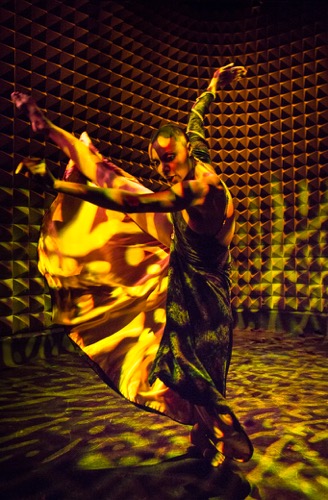
Khaleah London in her Prelude. Photo: Yi-Chun Wu
London (of Khaleah London/Layers), who dances Prelude to music that pits DJ Cisum against Moby, enters through the audience wearing a long, gold-lined black gown of her own design that bares her back, one arm, and her left leg. Her hair, like Fages’s, is cropped short. Her “prelude” may be the warm-up for a demanding task. She seems to be in a constant process of undulation; her long, snaking arms and torso only occasionally fall still—say when she shoots a leg high to the side. The music’s syrupy choral effects end before the dance does, and eventually yield to distant train (?) sounds. It’s in silence that London turns her back to us and frees us from her often sullen stare. What a back! Muscular, golden brown, the spine a deep cleft amid smooth muscles. It all but speaks to us.
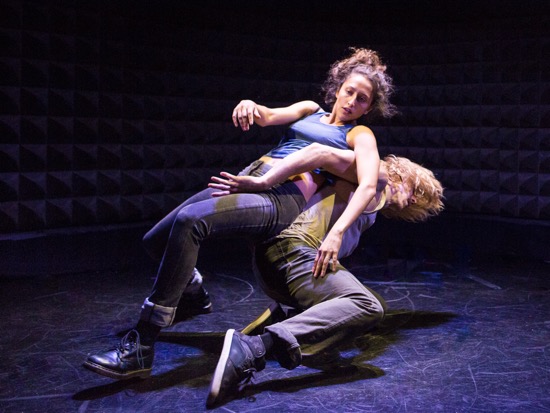
Shaina Branfman and Bryan Strimpel in their On We Go. Photo: Yi-Chun Wu
B.S. Movement’s On We Go owes its title to the accompanying music by Marquise Fair, but the term applies to the choreography’s ongoing flow. It’s to a heavy beat that Strimple starts slinging Branfman around. This primal couple may lunge in athletic unison, or slip into contact improvisation overachievement, but there’s a cave-man tenderness, as well as a slightly weary nonchalance to what they do (can you envision it?). They dance sitting down, as well as rolling on the floor, and pause a little more often than Fages and London do.
The pauses are welcome. These three works, in their different ways, churn on, as if one movement is being born only to generate another. The image created is of beautiful, endlessly supple human beings investigating in remarkable ways the flow of air around their bodies. Dance as compulsion, as addiction.
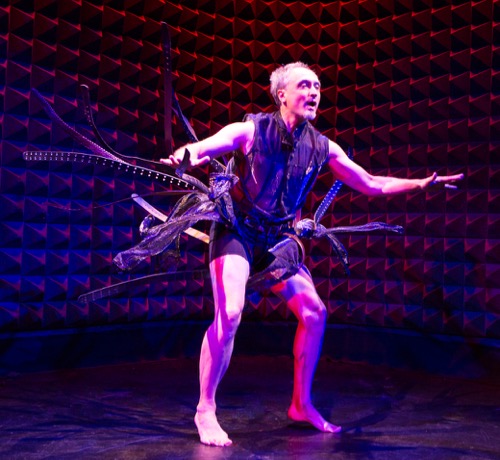
Patrik Widrig in his and still doing. . . . Photo: Yi-Chun Wu
Two of the works on the program fall more into the realm of self-exploration as modern dance defines it. Sara Pearson and Patrik Widrig of the almost 30-year-old PearsonWidrig DanceTheater present separate solos at Joe’s Pub. A condensed version of Widrig’s 2015 and still doing. . .was unfortunately undermined at the first Joe’s Pub performance by the fact that Widrig wasn’t miked and those of us not sitting close to the stage couldn’t hear what he was saying over Michael Wall’s powerfully atmospheric music. For this dance, Widrig wears a surprising costume—a black shirt and a skirt of dark, gleaming strips of various widths hanging from a wide belt (they could be leather); the effect is one of both confinement and wildness, since the strips flail about in the wake of his movements. His solo’s low, skimming jumps; collapses; falls; and precarious balances on one leg suggest an ordeal, and he often gazes into the distance as if assessing his progress. He walks forward, but is pulled back. At the end, I pick out words about (I think) Yoko Ono, who is (perhaps in a dream he had) performing “for a very long time.” I thought I heard him say this: “She was doing it because she could not do it.” He, on the other hand, could and did.
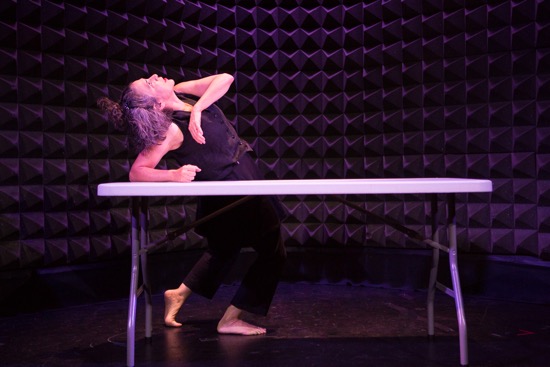
Sara Pearson in an excerpt from her The Beginning of Forgiveness. Photo: Yi-Chun Wu
Pearson, fortunately, was miked for an excerpt from her The Beginning of Forgiveness. This reminiscence about her years-ago piano teacher, Patrick Finney (also a ballet-class accompanist) tells of their friendship and how she and he and her-then boyfriend got stoned on mescalin together. She makes us see a long, nondescript table as a support, a precipice, and, maybe, a piano. She doesn’t pantomime playing an instrument, but, as she speaks her rueful, witty text, she occasionally lays her arms and body along the table—caressing it, resting on it, feeling its surface, getting wild on it, clinging to it as if afraid of slipping off. Finney, she finally tells us, committed suicide, and her last heart-twisting words before the lights go out are “No one could smoke a cigarette like he could.”
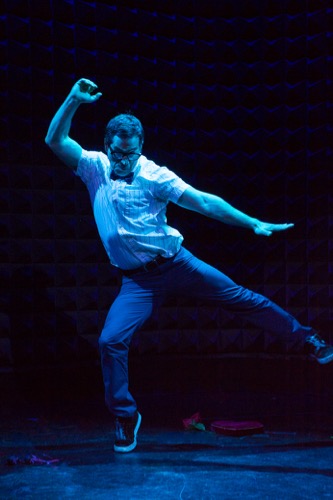
Mark Gindick in his First Love. Photo: Yi-Chun Wu
Three of the pieces we drink and possibly eat our way through are more like the acts you’d expect in an offbeat cabaret. In the first, a red balloon on a string is delivered down the aisle to Mark Gindick, bespectacled and clutching a little heart and some old flowers. He falls in love with the balloon anchored beside him, whispers to it, takes a selfie with it (which displeases the balloon). The lights turn blue, and he dances for his round, red love with sweet ineptitude, jigging his feet, attempting the Wave, looking around for approval. Gindick is a champ at sad-sackness. You can imagine the end, right? The accident, the shriveling, the mourning over red shreds? The last of three songs is Chris Stapleton’s “Everybody keeps tellin’ me to move on,/ Oh but I can’t seem to go anywhere without you.”
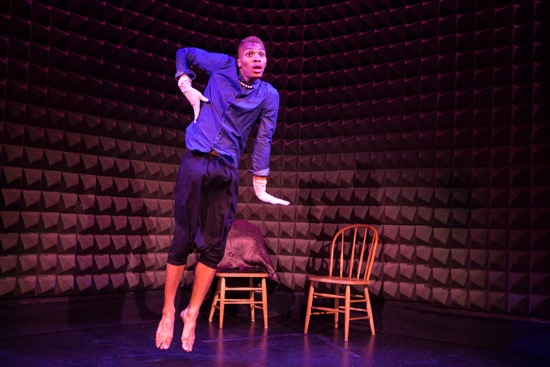
Sy Gaskin in Amber Sloan’s Yma Dream. Photo: Yi-Chun Wu
Amber Sloan’s Ima Dream owes a great deal to its agile, nervy performer, Sy Gaskin, who acts as the dreamer/narrator of the version of a 1962 New Yorker piece by Thomas Meehan that the author adapted for a television special featuring Anne Bancroft. It is Bancroft’s voice that guides the action.
There are two chairs on stage, one for the dreamer’s honored guest, the Brazilian singer, Yma Sumac. It is she who proposes that he save trouble and promote friendship by introducing her to the other guests by their first names only. The dream quickly turns into a nightmare, with Gaskin bustling between his chair and the apartment door and the celebrity guests becoming more and more irritated as the introductions proliferate; all have two-syllable names beginning with vowels that belong to the likes of Ava Gardner and Eva Gabor. Sample (from the original story): “Yma, Uta; Yma, Ava; Yma, Oona; Yma, Ona; Yma, Ida; Yma, Ugo; Yma, Abba; Yma, Ilya; Yma, Ira; Yma, Aga; Yma, Eva.” Gaskin dithers charmingly and frantically amid the unseen guests, saved from catastrophe only by the last visitor, who has a string of German names that begin with Wolfgang.
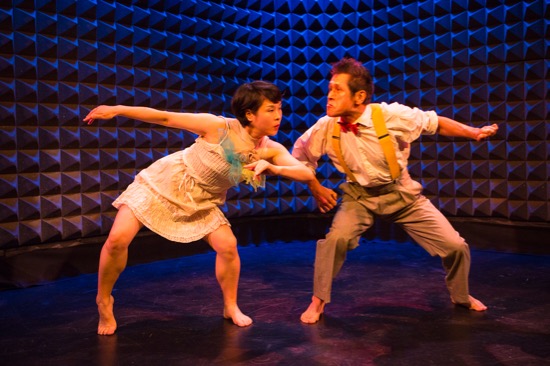
Rie Fukuzawa (L) and Satoshi Haga in their Faraway. Photo: Yi-Chun Wu
Satoshi Haga and Rie Fukuzawa have been working together as binbinFactory since 2010. This is not their first Dance Now appearance. He composed the music for their new Faraway, she designed the costumes, and they collaborated on the choreography. Fukuzawa is dressed like a girl doll you might not want to give your kid; Haga’s suspenders are pink. They stand stiffly side by side, looking a little goofy. The uncredited music sounds like someone practicing piano exercises.
Their relationship in Faraway progresses with sideways looks, silent laughs (hers a girlish tee-hee behind her hand), and a kiss with their lips stuck together and their bodies far apart. They flap their arms. When they travel around the space, they toddle. But enmity develops, along with distorted facial expressions. There’s a somewhat inscrutable ending with Fukuzawa producing one, then another green handkerchief from somewhere about her person and tossing each to the floor. After some clunky jumps, they kiss again. These are adroit performers. Who knows? We could be in a toyshop after dark.
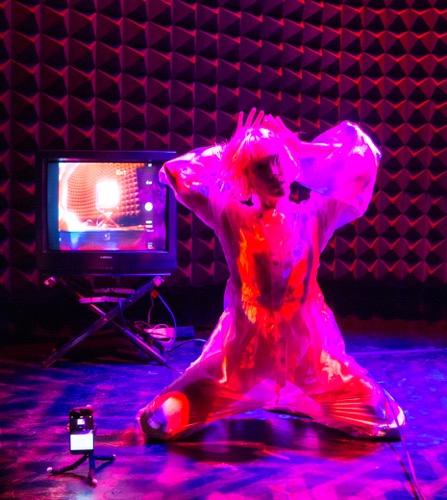
Katherine Helen Fisher in her Characters. Photo: Yi-Chun Wu
Katherine Helen Fisher’s Characters is an excerpt from a work-in progress, so I will say about it only that Fisher wears a striking semi-transparent outfit by James Kidd Studios and performs to music by Nelly Kate and Brent Delventhal, as well as to excerpts from Gertrude Stein’s The Making of Americans, as recorded by Stein. Fisher reveals herself to a camera and/or a phone, and we see the results on a low-lying monitor (her foot advancing on the lens becomes gigantic) in complex ways; she also shows it pictures of herself. Stein’s inscrutable blockbuster begins by identifying repetition; “more and more then everyone comes to be clearer to someone” is one of her riffs. I hope to see the finished project.
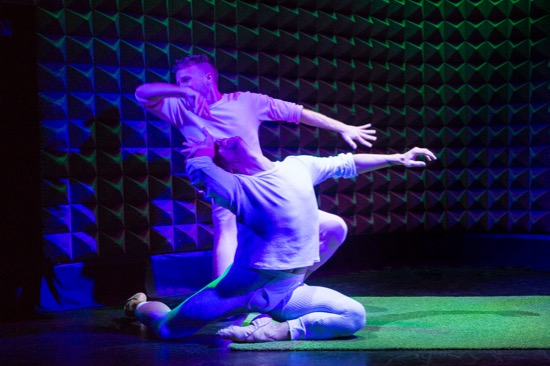
Jordan Isadore (front) and Edward Sturgis in their See Dick Dance. Photo: Yi-Chun Wu
That leaves the last piece of the evening: See Dick Dance. While Celine Dion sings, choreographer-performers Jordan Isadore in blue long underwear and Edward Sturgis in pink ditto stand side by side, just as Satoshi and Fukuzawa did, but they seem to be waiting stoically for roles to be thrust upon them. Follow spots stress the importance of the poses that they assume with staccato efficiency— poses that telegraph (and undermine) gender roles: cute-sexy, aggressive-sexy, and numerous more ambiguous ones. Sometimes one of them supports the other in a ballet moment; later, they’re chest-bumping in mid air. Sometimes they run through identical poses side by side.
See Dick Dance is ingeniously devised and timed. In this mischievous catalogue of split-second moments, the men stylize and repeat their gestures and pump them out with the music until they acquire an artful gloss. In the end Isadore faints into Sturgis’s arms like a distraught heroine, and the lights go out.
Finally, everyone who has danced that night gets to join the two men onstage and take a bow. We applaud them with the enthusiasm they deserve.
At the “Producers’s Picks Encore” on Thursday, September 29, you can see the “10 Top Tier Artists” chosen from this adventurous series, plus the “Festival Challenge Winner.”

Thanks Deborah for this thoughtful and beautifully written work despite the task at hand. Re the mic issue with Patrik, we tried to get him to use a mic but it was impossible with his very rough movement ( he would have broken the lavaliers) … floor mics were also in jeopardy of getting knocked over, so he choose to just try to project more — and I agree with you it was to the detriment of the work
Thanks for joining us!
Robin